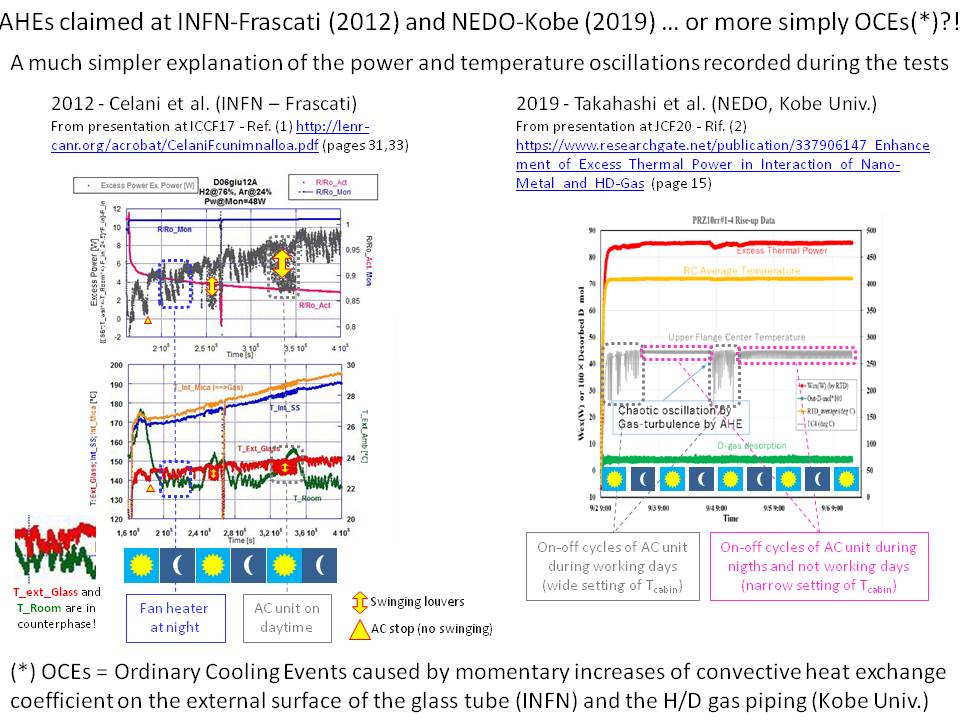AHEs at NEDO-Kobe. A much simpler explanation is OCEs (Ordinary Cooling Events)
Here is my answer to the question I asked to the L-F readers before the Christmas holydays (*).
(btw: HNY everybody!)
In the paper presented on last September at ICCF22, Takahashi et al. observed that:
| From https://www.researchgate.net/p…-Metal_and_HD-Gas_revised
In Fig.4, we show temperature evolution data for the #1-2 burst event. Obviously, the behavior of TC4 is very strange with many oscillatory down-spikes…. … … The oscillatory TC4 fluctuation looks chaotic as you see in Fig.7. This is regarded as an indication of strong local AHE, which makes H-gas turbulence by generation of chaotic up- and down-stream-paths of convection gas flow in RC. … |
and concluded:
| As new findings, the H(D)-gas turbulence effect in reaction chamber (RC) under strong AHE power becomes strong in our C-calorimetry system, when we have met strong local AHE power evolution in RC. This gas turbulence effect cooled the RC upper flange and generated chaotic temperature evolution of TC4 upper flange temperature and mostly decreased oil-outlet temperatures monitored at TC1 and TC2. … … Origin of AHE can be regarded as some nuclear origin … |
Well, IMO a much simpler explanation of the TC4's oscillatory fluctuation is provided in the following JPEG.

With reference to the right side of the JPEG, there is no need to postulate the existence of any nuclear AHE to explain the oscillatory behavior shown by the TC4 signal on many graphs of the most recent paper published by Takahashi et al. (1). The sequence of down spikes can be easily interpreted as the effect of Ordinary Cooling Events (OCEs) due to the intermittent operation of an Air Conditioning (AC) unit installed inside the cabin which hosts the Kobe's calorimeter. The on-off cycles are triggered by the ambient temperature settings. During the ON-phase, the MHE reactor is hit by an air flow at high speed which increases the convection heat exchange coefficient h on its external surfaces, by a factor many times higher than natural convection level. Due to the experimental set-up, this increased h causes a rapid cooling of the H/D gas pipe, which is welded on the upper flange of the Reaction Chamber (RC), whose temperature is measured by TC4. This flange is probably insulated from the rest of the RC cylinder by a non-metallic o-ring, so that its temperature is much more sensitive to the temperature of the external pipe, rather than the temperature of the rest of the RC cylinder. Successively, during the longer OFF-phase of the AC cycles, the coefficient h decreases to the level of natural convection and TC4 slowly go back to the higher base temperature. These alternations determine the typical behavior of these down-spikes, each one is formed by a rapid and shorter segment of a decreasing exponential branch, followed by a slower and longer segment of a rising exponential branch. They are just a manifestation of the cooling (and heating) law known since Newton's times!
As for the specific graph presented on the JPEG and extracted from page 15 of the most recent presentation of Takahashi et al. at JCF20 (1), the 2 periods of wider oscillations correspond to possible working hours. So, the larger amplitude of TC4 oscillations can be due to a wider values of the temperature settings of the AC unit during the presence of personnel in the cabin. During nights and the days with no human intervention inside the cabin, the AC cycles exhibited a regular pace triggered by a narrower settings of the on-off thresholds.
The NEDO-Kobe oscillations of TC4 are very similar to the power oscillation presented by Celani at NIWeek2012 in Austin, TX (2a) and at ICCF17 in S.Korea (2b), which are shown on the left side of the JPEG. There are a couple of main differences. As shown by the red curve, during the test, held at the beginning of June 2012, a fan heater was cyclically activated to avoid T_Room decreasing below 22°C during the nights. During these cycles, the T_Ext_Glass and the T_Room are in counterphase, ie, while the fan heater is ON, the first decreases and the second rises. This apparently contradictory behavior shows that the value of T_Ext_Glass, which was directly used to estimate the power output (black curve), is heavily affected by the velocity of the air flowing around the hot glass tube, which increases the coefficient of convective heat exchange and causes large drops of the glass temperature.
Conversely, during the warm days of June, the temperature in the lab rose to 25-27 °C and the AC unit was activated. In particular, during the 2nd and 3rd days, the large and frequent oscillations of the T_Ext_Glass temperature (red curve) and the Power output (black curve) are easily explained by the swinging of the louvers of the AC unit.
In conclusion, the ordinary cooling effects due to a discontinuous operation of the HVAC units are able to easily explain the oscillatory behavior of the curves presented as AHEs by Celani in 2012 and Takahashi in 2019. The same trivial phenomenon is also able to explain the results obtained by Saito et al. when they tested the Mizuno's cells at Hokkaido University of Science (3).
(*) The NEDO Initiative - Japan's Cold Fusion Programme
(1) https://www.researchgate.net/p…_of_Nano-Metal_and_HD-Gas
(2a) https://www.youtube.com/watch?v=Xe5rcEvsek0 [at 4:06]
(2b) http://lenr-canr.org/acrobat/CelaniFcunimnalloa.pdf
(3) MIZUNO REPLICATION AND MATERIALS ONLY
